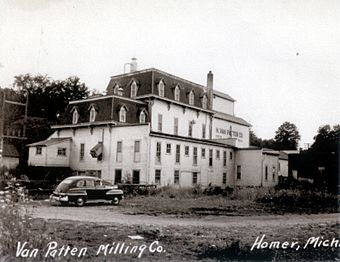Cortright-Van Patten Mill facts for kids
Quick facts for kids |
|
|
Cortright- H. Van Patten Co. Mill
|
|
 |
|
| Location | 109 Byron St., Homer, Michigan |
|---|---|
| Area | 2 acres (0.81 ha) |
| Built | 1887 |
| Built by | George A. McCartney |
| Demolished | May 16, 2010 |
| NRHP reference No. | 79001150 |
| Added to NRHP | August 31, 1979 |
The Cortright- H. Van Patten Co. Mill was an important old building in Homer, Michigan. It was a grist mill, which is a place where grain like wheat or corn is ground into flour or animal feed. This historic mill was located at 109 Byron Street. It was added to the National Register of Historic Places in 1979 because of its importance to history. Sadly, the mill was destroyed by a fire on May 17, 2010.
Contents
The Mill's Story: From Grain to Fun
Early Days: Building the Mill
The very first mill in Homer was built around 1837. It was likely in the same area where the Cortright- H. Van Patten Co. Mill later stood. In the 1850s, a man named Cornelius Cuykendall Cortright moved to Michigan.
In 1886, the original mill burned down. After this, Cornelius Cortright and his son, David, started a company together. In 1887, they built the main part of this new flour mill. They hired a local builder named George A. McCartney to construct it. Around 1910, a big addition was made to the mill, making it even larger.
New Owners and New Uses
The Cortright family ran the mill for many years. David W. Cortright, Cornelius's son, also had a farm nearby and managed the mill. In 1940, the H. Van Patten Company bought the mill from the Cortright family. They continued to operate it as a mill until 1970. Leon A. Van Patten, who was Harlow Van Patten's son, was in charge of the mill until it was sold again.
After being a working mill for so long, the building found new life! In 1974, James L. Miller bought the mill. He turned it into a dinner theater called "True Grist Ltd." Imagine watching a play while eating dinner in an old mill! The dinner theater was run by different owners until 1987.
Later, in 1996, John and Alice Blakemore bought the mill. They opened it as a restaurant and a place for special events. Then, in 2006, Lance and Susan Cuffle opened the Homer Mill. It was a restaurant, a bar, and even a haunted house!
The Fire of 2010
Sadly, the long history of the Cortright- H. Van Patten Co. Mill came to an end. On May 17, 2010, the mill was destroyed by a fire.
What Did the Mill Look Like?
The Cortright- H. Van Patten Co. Mill was a large and interesting building. It was made of wood and had different sections that were two, three, and even four stories tall. The outside of the building was covered with a special kind of siding called "novelty siding."
The original part of the mill, built in 1887, had decorative brackets under the roof edges. It also had unique "mansard roofs" with dormer windows sticking out. The parts added around 1910 had simpler gable and shed-style roofs.
For many years, the mill made "Victor Flour." Later, when the H. Van Patten Co. owned it, they changed its purpose. It became a place for storing grain and grinding custom feed for local farmers.

